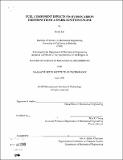Fuel component effects on hydrocarbon emissions from a spark-ignition engine
Author(s)
Liu, Helen, 1972-
DownloadFull printable version (2.967Mb)
Advisor
Wai K. Cheng.
Terms of use
Metadata
Show full item recordAbstract
A fuel component perturbation experiment was performed in order to determine the sensitivity of the engine-out emission levels of two olefins, 2-methylpropene (2MP) and 1,3-butadiene, to selected fuel components. In this experiment, a base fuel was perturbed with the following four major fuel components: MTBE, toluene, m,p-xylene, and iso-octane. For each of these components, new fuel mixtures were blended by increasing the percent volume of that particular component by three different increments. A spark-ignition engine was run at steady-state using these different fuel blends plus a baseline fuel with no perturbation. Samples were collected and analyzed using gas chromatography methods. Different hydrocarbon exhaust species were identified and quantified, and trends in any of these species were noted. The final results do indicate increasing trends in 2MP from the MTBE- and iso-octane- perturbed fuel blends. The sensitivity factor for the fuel MTBE/exhaust 2MP relationship was found to be approximately 3.582 x 10-5 g 2MP/(g fuel X % vol MTBE) using normalized data and 3.598 x 10-5 g 2MP/(g fuel X % Vol MTBE) using data corrected by an offset factor. For the iso-octane fuel mixture, the sensitivity was 3.287 x 10-5 g 2MP/(g fuel X % vol iso-oct) using normalized data and 3.500 x 10-5 g 2MP/(g fuel X % vol iso-oct) using data corrected by an offset factor. Perturbing the fuel with the aromatics did not have any noticeable effects on the exhaust hydrocarbon species. However, the exhaust samples from these fuel blends were also used in determining the MTBE and iso-octane sensitivities. By increasing the aromatic percent volumes, the percent volumes of MTBE and iso-octane in the fuel mixtures decreased. Neither MTBE, toluene, m-pxylene, nor iso-octane had any noticeable effect on the levels of 1,3-butadiene in the exhaust.
Description
Thesis (S.M.)--Massachusetts Institute of Technology, Dept. of Mechanical Engineering, 1998. Includes bibliographical references (p. 59-60).
Date issued
1998Department
Massachusetts Institute of Technology. Department of Mechanical EngineeringPublisher
Massachusetts Institute of Technology
Keywords
Mechanical Engineering